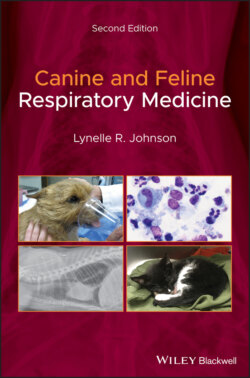Читать книгу Canine and Feline Respiratory Medicine - Lynelle Johnson R., Lynelle R. Johnson - Страница 21
Physical Examination
ОглавлениеOne of the more difficult challenges in assessing animals with respiratory disease is the development of good auscultation skills. Practice and patience are required because audible sounds are altered by age, body condition score, conformation, respiratory pattern, and the presence of disease. As mentioned earlier, careful examination should include the larynx and trachea, followed by auscultation of all lung fields. The anatomic origin for lung sounds has not been fully established; however, normal lung sounds are usually designated as bronchial, vesicular, or bronchovesicular. Bronchial sounds are loud and are heard best over the large airways near the hilus. Typically, they are louder and longer during expiration than inspiration and have a tubular character. Vesicular lung sounds are soft, heard best on inspiration, and can be detected over the periphery of the chest in normal animals. The sound resembles a breeze passing through leaves on a tree. Bronchovesicular sounds (a mixture of bronchial and vesicular qualities) are typically louder on inspiration than expiration.
Lung sounds in animals with airway or parenchymal disease are often increased in loudness or harshness, and harsh bronchovesicular sounds can be the only physical examination finding in animals with marked bronchopulmonary disease. Adventitious (abnormal) lung sounds (crackles and wheezes) are discontinuous noises and are not found as commonly as expected in respiratory patients, but should always be taken as an indicator of disease. Adventitious lung sounds can be enhanced by inducing a cough or a deep breath, or by exercising the patient. In normal animals, it is difficult to induce a cough by palpating the trachea; however, animals with airway or parenchymal disease usually have increased tracheal sensitivity due to activation of irritant receptors by infection or inflammation.
Crackles are thought to result from rapid opening of airways, but could also arise from equalization in pressure as air passes through fluid or mucus‐filled airways. They can be heard at any point during inspiration or expiration. Fine or soft crackles are suggestive of pulmonary edema, particularly if ausculted in the hilar region of a dog, whereas coarse crackles are more suggestive of airway or parenchymal disease. Dogs or cats with pulmonary fibrosis can display either fine or coarse crackles that are ausculted diffusely across the chest. Auscultation in dogs with airway collapse can reveal diffuse crackles because of the presence of concurrent bronchitis, or because of small airways that open and close during the phases of respiration. In the latter case, crackles are often present during both inspiration and expiration. A loud snapping sound over the hilar region at end expiration is suggestive of collapse of the intrathoracic trachea, carina, or mainstem bronchi. Wheezes result from air passing through airways narrowed by intraluminal mucus, extraluminal compression, or by collapse or constriction, and are usually heard on expiration.
